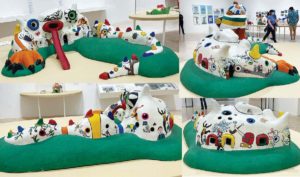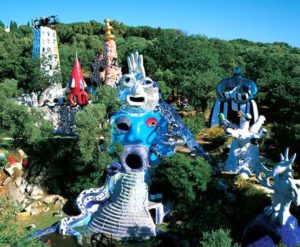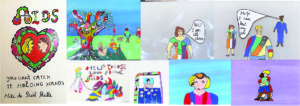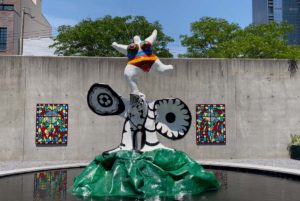
When I was living in Los Angeles I saw an amazing documentary at a small theater called,”Nicki De Saint Phalle, A Terrorist In Art.” The film was thrilling and showed Niki living a creative life in Europe surrounded by forward thinking artists and intellectuals who wanted to change the world. Little did I know I would see a retrospective of her work in all it’s glory at PS1 Moma years later, after I moved to New York. It was wonderful! When you walk through the door you are greeted by a large, happy, colorful, mother earth figure fountain spouting delightful streams of water that glimmer in the sunlight.
Niki De Saint Phalle was born in 1930 to a French father and American mother in France. They were wealthy but lost everything during the stock market crash of the 1930’s. But this fact didn’t stop her from becoming one of the most enduring artists of the 20th century. She spent most of her childhood in New York City returning regularly to France to visit family.
In the 1960’s when there was debate over a woman’s ability to forge her own identity and life path outside of traditional gender roles was just beginning, Niki De Saint Phalle was part of a movement of artists who addressed the theme of the independent woman.
She gained recognition in the 1960’s through the creation of her colorful, voluptuous, happy, nana figures (pictured above as the fountain and in the header). In her paintings, scultpures and films. She has always delighted in depicting women in diverse social roles and is considered an early activist for the feminist movement.
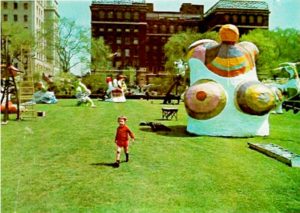
Niki and Jean’s work in Central Park.
She collaborated on a major sculpture project with Jean Tinguely which was titled Le Paradis Fantastique for the 1967 Universal Expo in Montreal. When the expo finished, the exhibition eventually ended up on the Conservatory Garden Lawn in Central Park, where they were on view for a year.
“Some love them. Some hate them. Some are scared to death. Everyone reacted.” Niki De Saint Phalle on reactions of La Paradis Fantastique in Central park.
She pushed the boundaries of what was considered art during the early 1960’s and 1970’s.
She was part of the avantegarde art movement and used a rifle to shoot at plasters filled with paint to create beautiful, spontaneous montages of color on plaster sculptures. She made plasters that displayed religious iconography and politicians current to the times. In a documentary at the exhibition she describes shooting as an artistic form of protest against a corrupt political establishment by making a plaster of Richard Nixon (as well as JFK), filling them with paint and shooting at them. Although self taught she displays an enormous amount of talent in her paintings and sculptures. Contemporaries such as Robert Rauschenberg, Jasper Johns, Brancusi, Duchamp and Dali often participated in her shooting art parties and films.
Niki was an activist who included all ethnicities in her sculptures and paintings.
She was ahead of her time when it came to representation. She lived through the civil rights movement and put those thoughts and ideologies to work immediately through her work and with the way she interacted with everyone around her. I’ve read accounts from people about her and she was an all inclusive, kind and down to earth person. Who was just as beautiful on the inside as well as the outside.
From the book Niki De Saint Phalle and the Tarot Garden, Here is an account from Marella Caracciolo Chia (daughter of the man who gave her a small, rocky, unused piece of land on their property for the Tarot Garden).
Marella Caraccciolo Chia,”I remember your feminity and beauty. You were like an alchemist, transforming objects and spaces that you came across. I have many good memories of the time spent with you, on Garaviccho as the garden was taking shape. It was a time of great social upheaval. the battles for and against abortion, the referendem for divorce and environmental issues coming to the surface. Though it was an exciting time for change, I remember my deep feelings of rootlessness and the Tarot Garden became a sort of refuge for me, and you a helpful guide.
You always saw the right side of every situation. Even in the most complicated moments of your adventure with the Tarot Garden, in the midst of health problems or beaurocratic complications, you always knew how to keep your head above water. There was no fear in your vision, only a sense of challenge and good sense of humor. “If the worst comes to the worst, you will have learned something important!” You would say. And of course you were right.
How much happiness you brought with you. How much space. I will always be thankful for that. You came into our lives like a Hindu deity, a feast for the eyes and the mind. You touched our lives. Especially mine.”

Niki imagined fantastic monsters in her paintings and sculptures that are whimsical two dimensional versions of her sculptures.
Before creating small maquette models, that would eventually be made into larger sculptures that could be climbed, slid down upon or walked inside of, Niki would start her artistic process with colorful drawings to guide Jean Tinguely and the craftsmen around her. The sketches were infused with the energy and spirit in which she wanted to bring forth in her three dimensional pieces. This is a an early sketch of The Tarot Garden which would later become her life’s work and lasting legacy.
Before launching into a large scale sculpture, Niki often created small maquettes (models) to work out three dimensional visual details.
Shown above are just a few of the pieces I saw at the exhibition. Although they are maquettes used mainly to create large scaled versions, they are still delightful works of art in their own right. Unfortunately, not every maquette that was created was realized as a large scale sculpture. This was mainly due to issues related to funding. If her pieces were approved as public art they were made into large scale works. If not, they remained just as they were…minature sculptures, still beautiful, but with unrealized potential as a large scale piece.
She created a fantastical wonderland called the Tarot Garden with her partner Jean Tinguely.
It is the culmination of her dreams and drawings realized in real form by her partner and a dedicated team of craftsmen who helped to make it come to life. Today people from around the world flock to Italy just to enjoy the monsters and creatures she has created from her imagination. Although mainly an attraction for children, it’s celebrated by art lovers of all ages.
Niki wrote a book about Aids and created a cartoon that educated people about HIV.
The cartoon was shown as a public announcement on French televison in 1988 and is produced by her son, Phillip. She also created a book for children with Dr. Silvio Barandun called, Aids, You Can’t Catch It From Holding Hands (shown above).
She became her own “patron”, designed and sold jewelry, scarves and perfume to fund her artistic endeavors.
Her perfume is available for sale to this day online. Anyone can own one of her pieces. It made her art more accessible to not just collectors, but the public at large. She enjoyed this democratic approach to collecting for the every man.
Her living sculptures are enjoyed by people (including many children) around the world.
Although Niki De Saint Phalle may no longer be with us (She died of lung related complications breathing in polyester fumes used in the creation of her large scaled sculptures in 2002). Her work will continue to be enjoyed by many people worldwide. Above are photos of 2 of her pieces located in San Diego, California, Large Seal 1999 and Queen Califa’s Magic Circle 2003.
Her granddaughter Bloum Cardenas, launched and runs the Niki Charitable Art Foundation. If you click on the link below, go to Niki De Saint Phalle in the subheading, then choose public works as the drop down. You will be able to navigate where each of her public pieces are located in the world. Enjoy!

